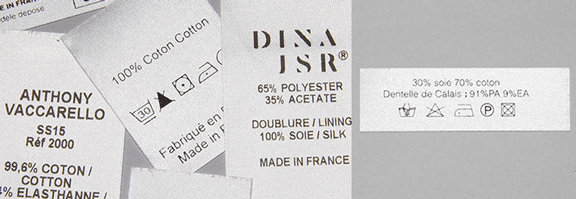We are familiar with labels that annoy us! It itches, it reveals, and you find this is pointless much of the time. According to an Ipsos research in 2014, 70% of people cut their labels after buying them. Consider, however, that a label reveals a lot about the product, beginning with how to care for your clothes. However, specific details are available to you, such as the size, origin, composition or mark. Griffes Vivienne will help you to understand these labels better.
The source’s comprehension
Given our preference for the local, learning more about the clothing’s origins could pique your curiosity. That’s a positive thing because, in the textile label, anything can happen whether you know how to read between the lines. Because, well, specific formulations will confuse you by combining the concepts of design and manufacturing. This is particularly true of the well-known phrases “Designed in France” or “French creation”: The distinction between creation and origin is deceptive in this case!
It’s worth noting that this detail would appear on a label if 45 per cent of the product were designed in France. If this is followed by the words “made in China,” it suggests that the design is undoubtedly local, but the manufacturing is done in China.
Comprehensive knowledge of the composition
Knowing which materials are being used by your clothes is critical for maintaining the garment, but you should also appreciate their longevity, characteristics, and benefits!
Textile fibres are divided into three categories:
Natural fibres, including cotton, linen, leather, angora, and merino wool, are included in this list.
Artificial fibres are made from natural materials that have been chemically treated. Specific methods, like viscose, can be polluting despite being framed. However, since they are manufactured in a closed circuit, they are environmentally friendly. This is particularly true when it comes to modal or lyocell.
Finally, synthetic fibres are generated by the synthesis of chemical compounds (petroleum). Polyester, nylon, elastane, and polyamide are a few examples. The theory is that each fibre has different benefits and a different life cycle.
Synthetics are not biodegradable, even though both natural and artificial fibres are. There are material mixtures that are more or less virtuous. It is your responsibility to open your eyes!
Become familiar with the garment care symbols
They are as complicated as they are helpful, so knowing them well allows you to care about your clothes over time while still reducing your environmental effects.
You should know that each symbol represents a particular meaning related to cleaning, bleaching, drying, and so on. At Griffes Vivienne, we believe that your clothes are like your friends; treating them well ensures that your friendship continues as long as possible and in the best possible conditions. Clothing is often worn prematurely as a result of prolonged high-temperature washing. Mainly, some natural fibres, such as wool, have self-laving properties that eliminate the need for washing. So, please don’t overdo it. You only need to know is how to read these symbols.
Being aware of labels
Clothing labels may represent a wide range of labels. They demonstrate the ethical or social obligations of the garment brands. So, do not ignore that they share the story of your clothing and that you can be labelled as “ethical fashioner” thanks to them.


